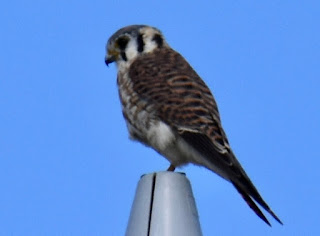Lake Apopka Wildlife Drive 12/9
My wife and I had a late flight out of Orlando, so I wanted to use part of the day to visit Lake Apopka Wildlife Drive. My wife, bless her, indulges me. Wildlife drive is about an hour drive from Orlando International Airport. Lake Apopka Wildlife Drive is very similar to Brigantine Wildlife Drive in Atlantic County, NJ. Both are one way auto loops stretching between eight and 11 miles long through local, natural habitat. Bird lists for both locations are well over 300 species. However, the Florida site is only open to vehicles from Friday to Sunday. Last August I visited the drive mid-week and the only access was on foot or bicycle. I walked about 7 miles that day in the Florida sun with practically no areas to seek shade. The upside was there were no mosquitoes or greenhead flies like the New Jersey site. This would be my only chance in the near future to enjoy the drive from a car.
When we entered the drive I had two target birds in mind. I wanted a snail kite which I had never seen before and a sedge wren which I’ve only heard, not seen. A snail kite had been seen well the day before circling over the small parking lot just outside the Lust Road entrance. Of course, a day usually makes a difference. Today the only raptor-like birds I could find were red-shouldered hawks, turkey vultures, osprey, northern harriers, bald eagle and a kestrel. Sedge wrens however were around. I heard several along the drive. I stopped at one spot where I heard three calling from the sedges. I saw one small wren scurrying through the vegetation near where I stood and took some photos. Unfortunately, when I was reviewing my photos later while waiting at the airport, that little wren turned out to be a marsh wren.
Some noteworthy misses on the day were roseate spoonbill, sora, black-crowned night-heron, limpkin and white pelican just to name a few. I could not find a least bittern, but we were surprised to have an American bittern fly in front of us and land in a stand of reeds. My wife got to see how this large bittern tries to camouflage itself in the reeds by stretching up its neck.
Unlike Brigantine, Lake Apopka is also home to alligators. These large reptiles are prevalent throughout the drive. Some are in the water, sometimes barely visible. Some are out basking in the sun, sometimes right along the road. It’s hard not to find any public body of water in Florida that doesn’t have a posted sign warning of the possibility that alligators are present.
















Comments
Post a Comment